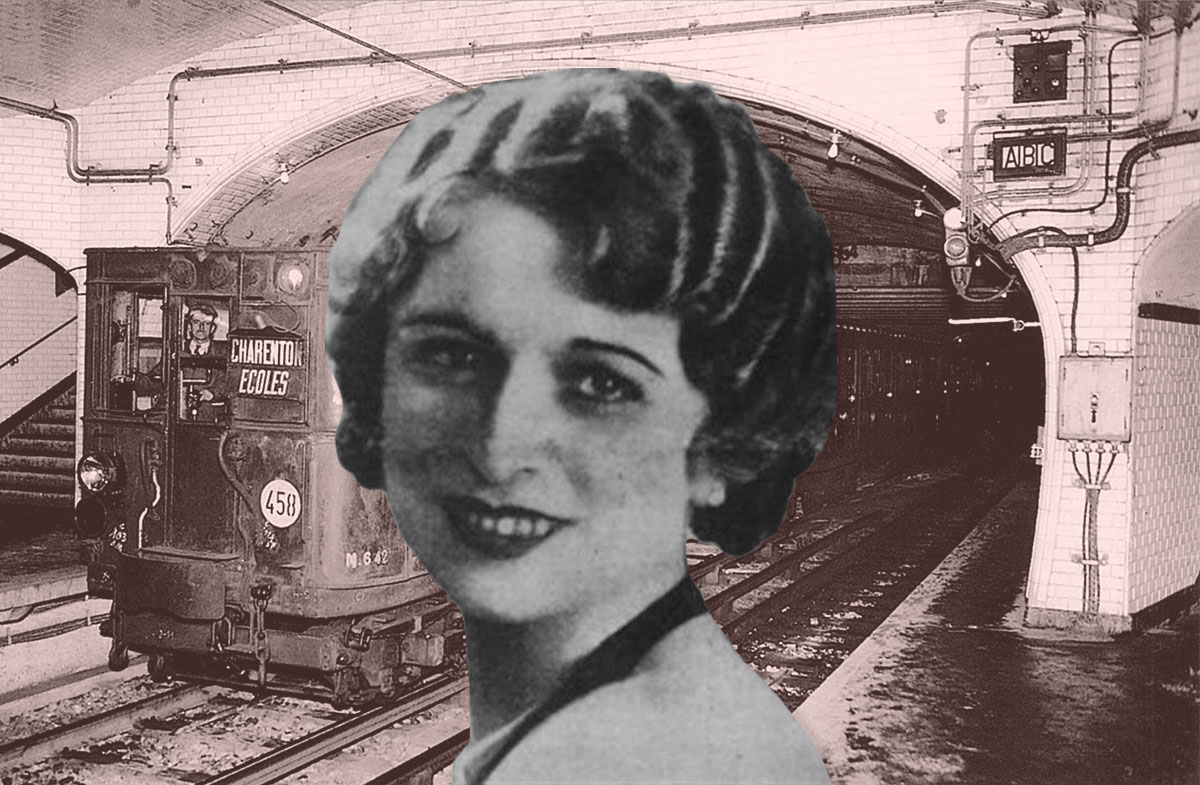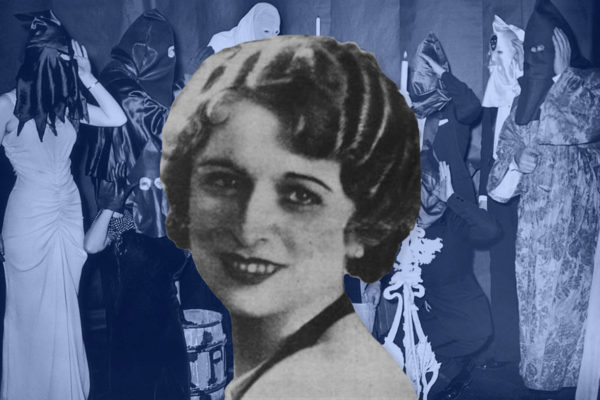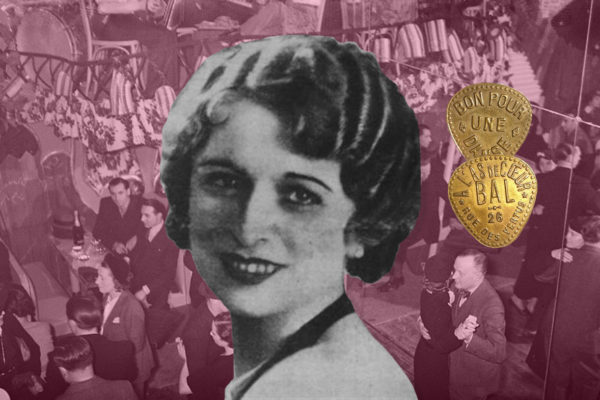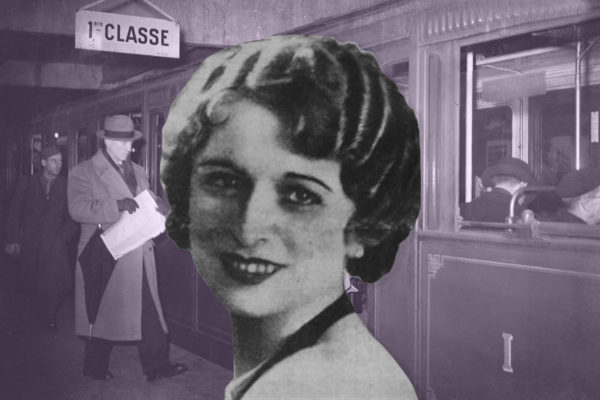
Murder on the Métro: Who killed Laetitia Toureaux, and how
The story began with a locked room mystery: an impossible murder played out in real life. How was it that Laetitia Toureaux boarded an empty train carriage alone, and was found a few minutes later at the next station dying from a stab wound to the throat? No one was seen getting into the carriage with her at the start, no one entered her first-class carriage from the internal doors while the train was in motion, nor did anyone get out when the train stopped. It didn’t make sense. And it is this conundrum, this Agatha Christie quality, that has kept the story alive for so long.
Whodunnit
But while this is an unsolved murder, there is a very strong suspect. In the conclusion to his report into the murder written at the time, Inspector Chenevier stated that all the evidence led to the Cagoule, the extreme right-wing group that was responsible for a string of killings in 1937. Police records from the time list Laetitia as a known associate of the Cagoule, though do not specificy the exact nature of her involvement. Was it because she was the lover of Gabriel Jeantet, a highly placed Cagoule officer, or did her connection go deeper? Laetitia worked for a private detective, and was an informant for both the French police and the Italian secret service. This experience would have served her well in the sort of clandestine activities (following targets, message carrying) that the Cagoule regularly used female members to carry out. Additionally, Laetitia was Italian – useful when the Cagoule was making secret arrangements with the Italian fascists to assassinate Italian dissidents in France in return for weapons. So were the Cagoule responsible for Laetitia’s murder? Let’s see what Chenevier meant when he named them as the number one suspect.
The case against the Cagoule
Firstly, the Cagoule carried out similar executions in France shortly before and after Laetitia’s death in May 1937. The first murder – that of Léon Jean-Baptiste – took place in October 1936, and the last – the killing of two policemen – was the September 1937 bombings. Most murders happened in the Paris area, the centre of Cagoule acitivities, putting Laetitia in the right place and the right time.
Secondly, the method of execution used on Laetitia was similar to that employed in other Cagoule slayings. Knives were the preferred weapon. Perhaps this was for practical reasons: because they were easy to procure – and silent – compared to guns. Or maybe there was a darker motive: the killer got a visceral thrill from plunging the blade into flesh. Impossible to say, but what we do know is that a great many of the murders attributed to the Cagoule were knife crimes. Dimitri Navachine and Léon Jean-Baptiste were knifed to death, Carlo and Nello Rosselli were stabbed and shot, while Maurice Juif was garroted, stabbed and shot. Laetitia’s death was different, however. She was stabbed only once – a clean business compared with the others. Was it a sort of courtesty, a nod to the fact that she was a woman? Or simply because there was no time – or need – to strike repeatedly?
What’s more, there was a degree of risk-taking that the crimes had in common. Navachine, the Rossellis and Toureaux were all killed during the day, and in public places. Granted, the male victims were in more secluded locations which suggests that there was a greater element of “seizing the moment” in Laetitia’s killing.
We know that the Cagoule were active at this time, were willing and able to carry out murders of a similar nature. One big question that remains is why they would want to kill Laetitia. The most persuasive theory is that Laetitia had betrayed or was about to betray the Cagoule, and she was killed in revenge. This is plausible because Laetitia had been a police informant for years, helping them keep tabs in the Italian immigrant population in Paris. It wouldn’t be too much of a stretch for her to supplement this with updates on Cagoulard actitivites, acting as a kind of a double agent. This scenario has added credibility when we consider the timing of events: Laetitia was killed in May and the Rosselli brothers were killed one month later. If Laetitia was used as a go-between with the Italians in negotiations for the Rosselli murders, she may have been afraid, finding herself implicated in a serious criminal plot. Those closest to Laetitia reported that she was unusually anxious in the lead up to her death. Did she plan to extricate herself from the situation by going to the police – and did the Cagoule get wind of her intentions? Members of the Cagoule who double-crossed the group paid with their lives. This was the fate of Léon Jean-Baptiste and Maurice Juif. When the Cagoule leaders discovered that the two were embezzelling funds designated to pay for weapons, they ordered their deaths. The pair went on the run but could not escape the reach of the Cagoule: both were found dead, months apart.
Confessions
One of the biggest obstacles in the police investigation into Laetita Toureaux’s murder was the absence of physical evidence or witness statements putting the Cagoule – or anyone – at the scene of the crime. No fingerprints were found on the weapon or areas the killer is likely to have touched (he was doubtlessly wearing gloves), the knife was widely sold so couldn’t be traced, and no one came forward to say they had seen anyone in the train carriage where Laetitia was attacked. Promising lines of enquiry lead nowhere and the case was growing cold. That was until early 1938 when events only tangentially related to the Toureaux investigation came to a head, and the police found themselves with not one but two confessions to the murder from Cagoule members.
After a series of criminal acts that included murders, sabotages, bombings, and culminated in a failed coup attempt, the French police finally acted against the Cagoule in November,1937. They carried out a series of raids and arrests, effectively putting an end to the far-right group. Among those taken into custody were high-ranking members of the organisation – including their leader Eugène Deloncle – and a great many lower ‘officers’. One of this latter category was a man named Pierre Locuty, an engineer who was instrumental in carrying out the September Etoile bombings. While in police custody in January 1938, Locuty gave a statement to the police about how Toureaux’s murder had been decided at a Cagoule meeting. He had been told this by François Méténier, a Cagoule leader, as proof of the group’s ruthlessness and power.
Another Cagoulard, Alain Jakubiez, told a similar story. He had been in police custody since September 1937 on arms trafficking charges. Jakubiez was closer to the group’s central figures, having taken part in the Rosselli brother murders along with Jean Filiol, the Cagoule’s main executioner. For this reason, his confession is all the more compelling – as is the fact that he was also able to name her murderer. In his police statement, Jakubiez said that Laetitia had been spying on the Cagoule for the French intelligence services, and was given a death sentence at a Cagoule meeting as punishment. In the weeks before her death she was followed by an André Tenaille, who watched her to establish her routine and find the right moment to strike. When the time came, Tenaille was able to point her out to the man who would kill her: Jean Filiol.
Jean Filiol, murderer
Should it be any surprise that the man who killed Dimitri Navachine, Carlo and Nello Rosselli was also named as Laetitia’s murder? Not really. This isn’t an Agatha Christie story with a cleverly concealed murderer revealed in the last act; this is real life where the prime suspect is just that for a reason. It’s worth stating again that Laetitia Toureaux’s murder has never been solved, and Jean Filiol was never charged, but – in my opinion, he is the person most likely to have been reponsible for her death.
The police chose not to pursue the confessions, though their reasons for doing so are unknown. Pierre Locuty retracted his statement not long afterwards, saying it had been given under duress. But it is likely that a far bigger factor in their decision was Jean Filiol’s absence. He had fled the country in the summer of 1937 and was at that time – although unknown to the French justice system – fighting for the Nationalist forces in Spain. Filiol was convicted in absentia of the Rosselli murders but was able to return to France in 1941, now under Nazi occupation with the cooperation of the Vichy government. Eventually Filiol joined the Milice, a French group that was compared to the Gestapo, and was given the task of ousting the Resistance from Limoges region. During this time Filiol interrogated and tortured Resistance members, and supplied intelligence to the Nazis that was instrumental in their decision to massacre the entire 643 inhabitants of a town, Oradour-sur-Galne, including 200 children.
After the war, Filiol returned to Spain. The Spanish government refused French extradition requests so Filiol never faced justice for his crimes before or during the war. He was employed by L’Oreal (who also funded the Cagoule) and died of natural causes some time in the 1950s.
The locked room unlocked
The preoccupation of solving Laetitia Toureaux’s murder has rightly focussed on who was responsible – and we likely know who that is. But the other question has always been how? How could she have entered the train alive, and be dying by the time the train reached the next stop, with no one seen entering or exiting the closed carriage. The answer to that is, like that of who killed her, the most obvious of all. One that was speculated in the newspapers in the days following her death. Returning to the murder mystery theme one final time, a quote from Sherlock Holmes comes to mind.
When you have eliminated all which is impossible, then whatever remains, however improbable, must be the truth.
The Adventure of the Blanched Soldier, Sir Arthur Conan Doyle
There are three scenarios in which Laetitia Toureaux could have been murdered:
- while the train travelled between stations
- at Porte Dorée station, where the train arrived
- at Porte de Charenton station, where the train departed
Let’s take these in turn.
She couldn’t have been murdered during the train journey because a) the train was travelling too fast for a person to leap off, and survive, while it was in motion, and b) the internal doors were locked and – again, no one saw anyone enter or exit first class. We have to exclude this option.
What about Porte Dorée? The behaviour of the army dentist (who left in a hurry and took days to come forward to the police) was suspicious but, ultimately, there was no more to it than that. Six people – two groups of three, unknown to one another – entered the first class carriage at Porte Dorée station and all agreed that Laetitia was found there injured and alone, and no one had exited the carriage as they entered. It’s too many people to be discounted, and so we must put this option aside.
This leaves us with an attack at Porte Charenton. Let’s look more closely at what happened there.
Laetitia Toureaux boarded the Métro train at Porte de Charenton station heading west into central Paris. In 1937, Porte de Charenton was first stop on the line, which is meaningful when considering the timing of the crime. A train arriving at a terminus spends more time on the platform: firstly to allow passengers to get off, and secondly to depart at the scheduled time. In practice this means that passengers, once boarded, have a longer wait than at a regular station before the train takes off. This extra time may well be the key to unlocking the locked room mystery.
Consider the situation. When Laetitia arrived on the platform that Sunday evening, the 16th of May, there were over 100 people waiting for the train. (Remember, the next day was a public holiday so people were going out for a night out on the town, Laetitia included.) While some might argue that this meant that there were 100 witnesses, we can equally say that there was a crowd into which a killer could pass unnoticed. Laetitia waited on the platform for the train; as it arrived and was emptied of passengers, those people waiting pressed forward, eager to board, single-minded in their determination to find a seat. Only Laetitia got into the first-class carriage; she entered at 6.25 pm, sat down and waited for the train to depart. When it did, finally, at 6.27 pm, it is probable that Laetitia was already dying.
This window of time – the 90-to-120 seconds while the train idled on the platform – would have been enough for the killer to act. He followed her into first class – unobserved, since the other passengers were focussed on boarding – and attacked her from behind. The killer stabbed her only once – a single, effective blow that cut her jugular – which would have taken only seconds. He could then have got off the train and either exited the station, or got into a different carriage. There was unlikely to have been noticable blood stains on his clothes since it was a single stab and the knife was left in the wound, stemming the blood flow. When the train engineer – who later provided a witness statement saying that Laetitia was alive and alone as the train departed Porte de Charenton – saw Laetitia sitting upright in her seat, he wouldn’t have realised that she was already dying. The knife was on the right side of her neck, concealed from his view. The blade had cut her spinal cord, paralysing her to the spot, leaving her unable to move, to gesture or cry out for help. Her final movement – falling from her seat onto the carriage floor – was involuntary, a result of the brakes being applied as the train came to a halt in the next station.
This is the scenario that I consider to be the most realistic, the only one that allows enough time for a killer – Jean Filiol – to enter, commit the crime, and escape. Presumably, Filiol and Tenaille had been tracking Laetitia’s movements that day; they had followed her from her home to her mother’s house where she enjoyed Sunday lunch with her family, they tracked her to the bal musette where she had danced with her brother and friends, they saw her leave, get onto the bus, and they followed it by car to Porte de Charenton Métro station. There Laetitia got off the bus, intending to continue her journey to central Paris where she was to meet her sister and brother-in-law at a celebration dinner for Italian immigrants. Filiol got out of the car, bought a ticket, passed through the turnstile and descended the steps onto the platform, watching and waiting, ready to strike.
Previous posts
Part one: Murder on the Paris Métro: the unsolved death and mysterious life of Laetitia Toureaux
Part two: Murder on the Paris Métro: the double life of Laetitia Toureaux
Part three: Murder on the Paris Métro: Laetitia Toureaux and the French fascists
Sources
My main source for this article is this excellent book Murder in the Métro: Laetitia Toureaux and the Cagoule in 1930s France by Gayle K. Brunelle, Annette Finley-Croswhite (LSU Press) which helped fill in lots of blanks and straightened out some of the conflicting information I’d come across. It’s worth mentioning that these authors come to an entirely different conclusion than I do about what happened to Laetitia. I’ve also read a great many contemporary newspaper accounts via RetroNews.fr, the excellent French-language newspaper catalogue run by the French National Library. Finally, a big mention should go to the site Crimocorpus.org, a Museum of Crime, Justice and Punishment, via which I was able to access Detective (various issues), a French-language magazine that covered the story in great depth.




